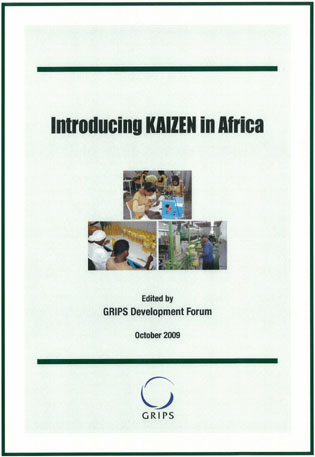|
  Introducing
KAIZEN in Africa (PDF708KB) Introducing
KAIZEN in Africa (PDF708KB)
(October2009) Japan
assimilated and developed the American method of improving quality and
productivity as gkaizenh after 1950s. It drew attentions of the world after
1980s, because of Japan's improvement of competitive strengths. As a result,
Kaizen began to be adapted to the West and other developing countries.
Kaizen assistance by Japanese ODA has been implemented in Asia (ex:
Singapore), Latin America (ex: Brazil, Castalia), and South Africa recently
(Egypt, Tunisia). Ethiopia is also showing strong interest in Japanese
development experiences and introducing kaizen in Ethiopian firms. This book
aims to introduce the basic concept and characteristics of kaizen to African
audience and explain how Japan has implemented kaizen assistance in
developing countries. It also discusses the factors that affect the
performance of international kaizen assistance. Kaizen is
applicable not only to the manufacturing sector but also to the service
sector, public organizations, and non-profit organizations. This book also
provides information on the history of Japan's quality and productivity
improvement. (October 2009, GRIPS Development Forum) If you wish to have a
hard copy, please email us. |
|
 Mission
Report to Germany and the UK (PDF210KB) Mission
Report to Germany and the UK (PDF210KB)
(August2009) Prof. Izumi Ohno and Sayoko Uesu (research associate) visited
Germany (Bonn, Eschborn, Frankfurt) and the UK (London) during July 28 to
August 6, 2009 and met policymakers, practitioners, and researchers in the
areas of development cooperation, especially on industrial development and
public-private partnerships. While the UK focuses on the gmarket development
approachh with attention to market functions and the business
environment, Germany takes gmulti-level approachh paying attention not only
to the investment and business climate (macro-level), but also to industrial
structure and inter-firm linkages (meso-and micro-levels). Given some
commonalities found in German and Japanese approaches to industrial
development, it appears that there exist scope for the two countries to
promote further mutual learning and disseminate jointly their approaches. We
also visited the DFID-funded, International Growth Center, which is
initiating growth policy engagement in selected African and South Asian
countries. In both Germany and the UK, we have felt their strong interest in
the East Asian development experiences and Japan's approach to growth
support. |




